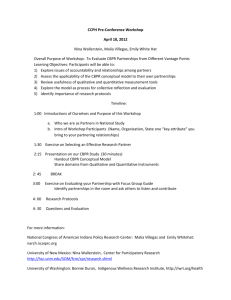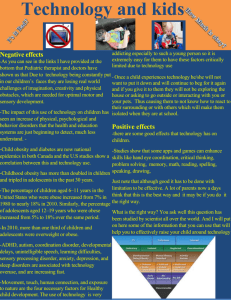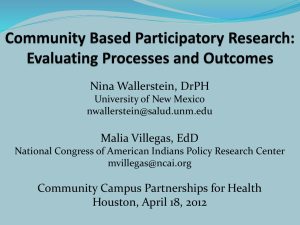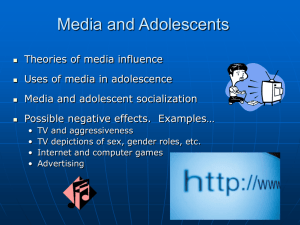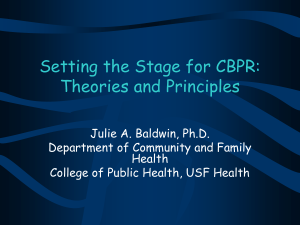The Pittsburgh Bridge: A Gateway for the Future
advertisement
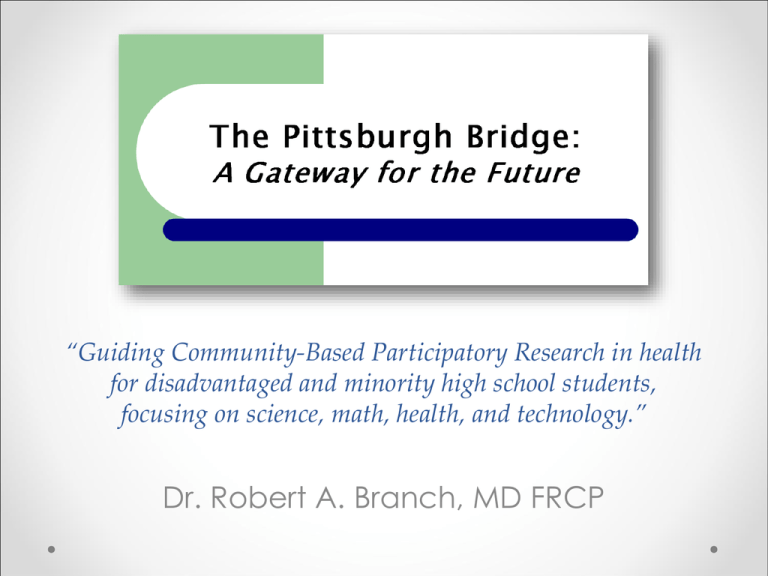
“Guiding Community-Based Participatory Research in health for disadvantaged and minority high school students, focusing on science, math, health, and technology.” Dr. Robert A. Branch, MD FRCP Objectives • The Problem o Health o Education o inadequate Literate Workforce • The solution o Pitt-Bridge o Salutogenesis (origin of health) o Micro-Community-Based Participatory Research (CBPR) • Uniqueness o Tiered Diffusion Communication o Application Psychology o Adolescents • Vehicles for Change o Knowledge Brokers o Continuous Self-Monitoring • Feasibility o Rural West Virginia • Career Development • Adolescent Health • Community Health Can We Apply These Concepts to Pittsburgh? Who is Robert A. Branch? Call me ‘Bob’ • Born in Nairobi , Kenya in 2nd world war • Father is a physician o from St. Lucia • Mother is a nurse o from England • Raised in Nigeria • Schooled in England • Bristol Medical School o 17 years old o qualified by 22 years • Internal Medicine in UK • Emigrated 1975 • Vanderbilt for 17 years o Clinical Pharmacologist • Pittsburgh for 22 years o Clinical Translational Scientist *An Educator for over 50 years* The US Health: An International Perspective • Shorter Lives, Poorer Health o US National Research Council o Congress Requested Institute of Medicine o January 2013 • US Health Disadvantages “Knowing is not enough; we must apply. Willing is not enough; we must do.” -Johann Wolfgang von Goethe The Cause “Even if health care plays some role, decades of research have documented health is determined by more than health care.” -2006 Report on Comparison of UK and US Social Gradient ---------------------------- Income Inequality At every social level UK>US United States United Kingdom • “My right to choose.” • Individualism • “We are all in this together.” • Collectivism The Problem: Mal-Adaptive Behavior Related Diseases Worse outcomes than 17 other countries Spends greater than 2x per capita than other countries Acute Events • Adverse Births • Vehicular Accidents • Violence • STDs Chronic Events • Obesity • Type II Diabetes • Cardiovascular Disease • Chronic Pulmonary Disease • AIDS • Lung Cancer Creating Change in Health Who is to create change? • Government o Incapable of Action • Philanthropy o Inadequate Funding • Advocacy o Inadequate Federal and State Funding We need to find a new way! Public health. Confronting the Sorry State of U.S. Health. Bayer R, Fairchild AL, Hopper K, Nathanson CA. Science. 2013 Aug 30;341(6149):962-3. doi: 10.1126/science.1241249. PMID: 23990546 Bridging the Gap - + Federal Community Time Interpersonal + - Impact Institutional Individual Creating Change in Health Identify the Cause o Misdistribution • Money • Knowledge of Community • Behavior of Family Involve Everyone o o o o Community Educators Health Care Providers Policy Makers Use Adolescents • • • Target the Most Vulnerable o o o o Poverty Minorities Rural Urban Communities • Most Flexible Technologically Advanced Already Established in the Community Responsible Seismic Changes in STEM Education • Need for change o o o National decrease in competitiveness Concern of future high-tech work force Disgrace over differential State Standards • Questions raised o o o What do we teach? What is learned? When do we teach it? When is it learned? How do we teach? How is it learned? • Mathematics o The Common Core State Standards • http://www.corestandards.org/resources/key-points-in-mathematics • Sciences o The New Generation State Standards • http://www.nextgenscience.org/next-generation-science-standards Pennsylvania conservative resistance to change Pitt-Bridge Vision and Goals • Vision o Provide a “Bridge" Between Health Sciences and STEM Disciplines o Learn How to Learn o Learn How to Change Behavior • Goals o Motivate minority and low-income high school students to enter higher education o Pursue careers in STEM fields, particularly in health sciences-related occupations. o Family improvement of health o Self-improvement of health CBPR Learning Program Health Science Clubs A Transformative Education Health Science Program: Requires Integration of Essential Core Concepts • • • • • • • Salutogenesis (origin of health- for community) Adaptive Adolescent Hypothesis Micro and macro CBPR Application of cognitive psychology in scientific method Community Research Knowledge Broker (CRKB) Tiered Diffusion model of communication Adolescents as family health care coaches Salutogenesis *Origin of Health & Wellness for All* Vaccination Prevention Time Actionable Knowledge Concepts Prophylaxis of Chronic Disease Adaptive Adolescent Hypothesis Brain Maturation • Burst of brain growth and change in structure o o Pruning of dendrites Development fast track neuronal connections. Wave of Brain Maturation • 1st Step: 12 years o Dexterity • 2nd Step:15-19 years o Concept Integration • Final Step: 21years o Executive Decision Making Source: J. Giedd, Nature 442, 865-867 (24 August 2006) Adaptive Adolescent Hypothesis Implication confers evolutionary benefit • Risk taking may be an advantage in times of peril Ability to use reasoned choice to not conform to culturally acquired maladaptive behavior’s may be our best option for survival. Community-Based Participatory Research Core Values • Mutuality o Sharing by Members • Equity o Governance o Accountability • Trust o Good Faith From All Partners Community-Based Participatory Research: A Capacity-Building Approach for Policy Advocacy Aimed at Eliminating Health Disparities Israel BA, Coombe CM, Cheezum RR, Schulz AJ, McGranaghan RJ, Lichtenstein R, Reyes AG, Clement J, Burris A. Am J Public Health. 2010 Nov;100(11):2094-102. doi: 10.2105/AJPH.2009.170506. Epub 2010 Sep 23. PMID: 20864728 PMCID: PMC2951933 Core Principles of CBPR • Long-Term Commitment • Equitable Partnership in All Phases • Emphasizes Local Relevance • Builds on community strengths and resources • Promotes Co-Learning and Capacity-Building Micro-CBPR for Student Investigators My ‘FIRST’ Health Project Micro-CBPR Scientific Project Fun Innovative • Individual • Iterative Relevant • Respect • Relationships Scientific Transformative a) Subject Area b) Background c) Question d) Design & Approval e) Implementation f) Analysis & Inference g) Presentation If a common data collection tool is used, the sum of multiple Micro-CBPR generates bonefide CBPR Who are ‘ ’ in Micro-CBPR of Health? Who are ‘WE’? • Who is the We? • Where do We live? • What is our environment? • What are our health problems? Why do ‘WE’ do what we do? • How do We learn? • How do We make decisions? • How do We change? Can ‘WE’ do better? All Questions Require, Comparisons, Quantitation, Analysis Potential to Enhance Health A Community in Trouble Adverse, Culturally-Based, Behavior Adolescent-Led Micro-CBPR Projects Adaption Behaviors Improve Community Awareness Learning to Learn Ausubel’s Theory of Meaningful Learning Community Science Project Change in Behavior Prochaska’s Trans-Theoretical Model of Behavior Change The potential for the CBPR Learning Paradigm to enhance health Clinical Research Knowledge Broker A New Community-Based Career Track Who are they? • Recruited from senior STEM teachers with higher pay • Live in and know the local community • Receive special training in o o o o Ethics principles of CBPR study design domains of health sciences interest What do they do? • • • • Organize integration of club activities Mentor club teachers Organize club group symposia Maintain and evaluate quality Tiered Diffusion BiDirectional Communication STEM Teachers Knowledge Brokers Science Club Students Academic Medical Centers Science Club Families Pitt-Bridge *Science Club= 1 Teacher / 10 Students CBPR Learning Paradigm (Teacher Activity) Teach KB Teachers Train Students Teach Teachers Individual Student Project Selection Symposia Presentation (Student Activity) Change In Behavior “Learning by Doing” Community Project Using Scientific Method Learning Doing Evaluation & Feedback → New Challenge for Next Cycle Concept Map Networking Approach Study Hypothesis Study Rationale Sociology of Family Home Economics Diabetes Intervention Structure Conduct Nutrition Pre/Post Cohort Of Mothers Logistics Portion Size Endpoint Measures Energy Balance Exercise Complications CBPR Food Labels Energy Cardiovascular Disease Heart Attack Ethics Research Regulation Obesity Epidemic Metabolic Syndrome Design & Conduct Training Education Program Diet Stroke Protein Data Collection Data Analysis Carbohydrate Fat Data Organization CBPR Learning Paradigm • Educational Perspective o Integrate Common Core State Standards (CCSS) and the Next Generation Science Standards (NGSS) by expanding into health sciences • Student Perspective o Involve hands-on experiences in ethics, science-based problem-solving, leadership, team-building, decision-making, and concept presentation in health sciences • Community Perspective o These students will gain the knowledge, skills, and ability to become family health care educators to promote wellness. Feasibility Model • Encourage o o o o o Entrepreneurship Self-Reliance Team Work Learn How To Learn Self Expectation • Mission Health Science & Technology Academy (HSTA) o Community organizations in 26 counties o 76 Science clubs for high school o 4 Community Research Associates o Links to WVU and Pitt o Go To College o Succeed in Career Development o Improve Community Health HSTA Club Enrollment 2011 Enrollment Statistics 1st Generation College 53% Food Voucher Aid 40% Rural 73% African American 30% (3% Statewide) Total 786 Students HSTA College Entry Success Analysis of 1267 HSTA Graduates HSTA Graduates WV High School Graduates Enrolled in College 96% 59% Matriculated from College 92% 56% STEM Degree 49% 38% In College 745 4 Year Degree 354 Masters Degree 62 PhD, PharmD, MD 40 MD 10 Obesity in West Virginia Subjects enrolled in 2007 Prevalence of Obesity and Diabetes (2007) Projected Mean BMI for Adolescent Cohort BMI in HSTA family sample populations of West Virginia in subjects as they age from the present time. The slope of projections is estimated assuming the linear increase observed from the BRFFS study results from WV between 1985-2007 remains unchanged Community-Based Participatory Research 2007 2008 2009 2010 2011 2012 2013 Adults 648 56 356 40 125 103 100 % Obese (BMI>30) 40 35 41 42 42 39 40 29 +/- 6 29 +/- 7 29 +/- 7 32 +/- 12 29 +/- 7 29 +/- 7 31 +/- 9 300 253 132 53 57 40 52 15 +/- 2.7 14 +/- 3.4 14 +/- 3.2 16 +/- 2.2 14 +/- 3.2 14 +/- 3.2 14 +/- 3.3 23 +/- 6 23 +/- 6 24 +/- 6 24 +/- 6 23 +/- 5 23 +/-6 24 +/- 7 BMI (mean +/- SD) Adolescents Age (mean +/- SD) BMI (mean +/- SD) CDC Reported 6% increase in adult BMI 2007-2012 Lessons Learned in Community Health • Transition of HSTA coordinator to Community Research Knowledge Broker • Adolescents can conduct Micro-CBPR • Integration of related Micro-CBPR permits Community CPBR • Multiple Micro-CBPR projects influences community behavior for health care condition Proposed Plan of Action The Pittsburgh Bridge • Stakeholders o Community o Pittsburgh Public Schools o Academia • Governance o Community Leadership o Advisory Committees • Evaluation • Funding Phased Introduction • Phase 1: Initiate and Learn • Phase 2: Refine and Consolidate • Phase 3: Expansion Publications • Branch RA, Paulsen S, Hanks S, Obesity Management Organized by Adolescents in Rural Appalachia, JHUP Fall 2014 (in press) • Branch, R., Chester, A., Morton-McSwain, C., Hanks, S. Udin Al Ayubi, S., Bhat Shelbert, K., Brimson, P., Buch, S., et al. A Novel Approach to Adolescent Obesity in Rural Appalachia of West Virginia: Educating Adolescents as Family Health Coaches and Research Investigators. Topics in the Prevention, Treatment and Complications of Type 2 Diabetes." Mark B. Zimering (ED) (2011). ISBN:9780953-307-590-7, InTech. • Bardwell, G., Branch, R.A.,Buch, S., Cecchetti, A.,Chester, A., Groark, S.,Morton, C., Pancoska, P., Paulsen, S.,Vecchio, M." (2009, October).Feasability of Adolescents to Conduct Community Based Participatory Research on Obesity and Diabetes in Rural Appalachia." Clinical Translation Science.2(5) • Chester, A, and R.A. Branch. Community Based Participatory Clinical Research in Obesity by Adolescents; Pipeline for Researchers of the Future. Clinical Translation Science. (2009). • Pancoska P, Branch RA, Buch S, Cecchetti A, Parmanto B, Vecchio M et al. (2009) Family Networks of Obesity and Type 2 Diabetes in Rural Appalachia. Clinical and Translational Science 2(6):413-421. http://www.wiley.com/bw/journal.asp?ref=1752-8054
